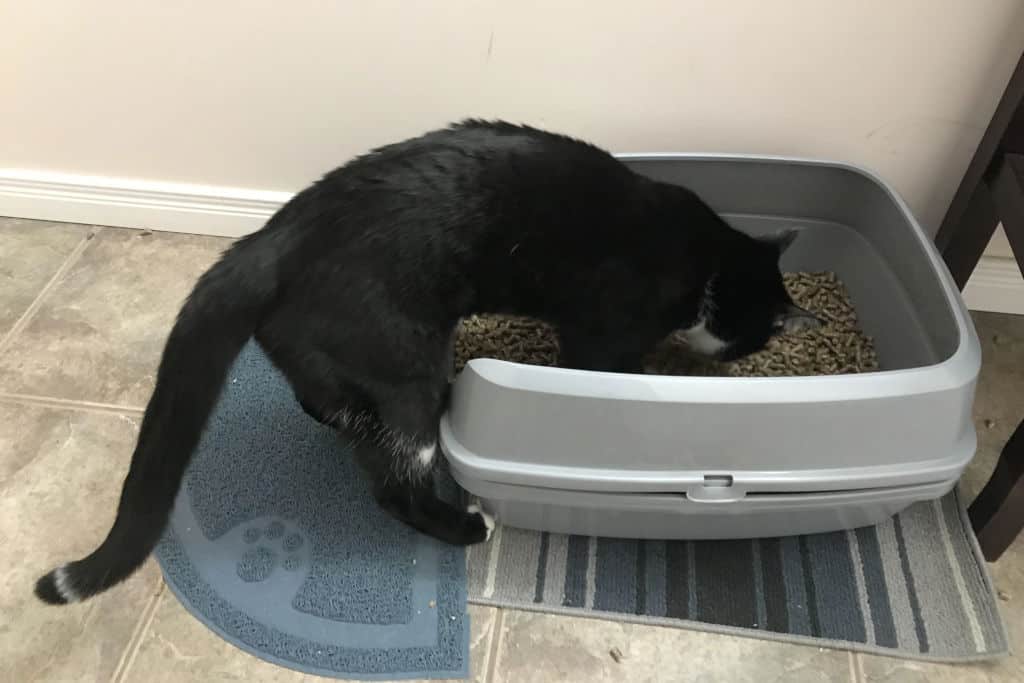Disclosure: We may earn a commission from helpful, relevant links in our content. No cost to you. See our privacy policy.
New cats sometimes take some time to get back to a normal routine. But it’s crucial to know what is not normal and what to expect when your new cat is not going to the bathroom.
This article explores behavior in newly adopted cats regarding a litterbox, how to get a cat to use the litter box, and health concerns to watch out for.

What Is Normal Behavior for an Adopted Cat?
Adopted cats should use the litterbox regularly, bury their waste, and avoid accidents outside the box.
However, privacy and comfort are important considerations. If the kitty does not feel at ease or has nowhere to hide, she may feel vulnerable and misbehave until she feels secure and comfortable in the new environment.
If the cat is hiding, don’t try to coax it out, as this may create extra stress. Allow the cat to emerge, investigate, and use the litter box on their own terms.
Remember that a new cat might need an adjustment period to associate the litter box with its purpose. Setting up a routine, like guiding them post-meal to the litter area, can encourage usage.
Is It Normal for a New Cat Not to Use the Litter Box?
It’s not uncommon for cats to have difficulty pooping in new places. Environmental changes can be overwhelming for cats. For instance, if your home has multiple floors and the cat was previously in a single-story shelter, it might take longer for it to navigate and locate the litter box.
Constipation can be caused by anxiety about a new home in all animals. However, there may be a few cases where the cat’s behavior is out of the ordinary.
The first thing we need to distinguish here is:
- whether the cat is going to the bathroom outside the litterbox
- or the cat is not pooping/peeing at all.
If it’s the first one, and the cat is simply avoiding the litterbox, then it’s just a matter of preference, adaptation, and getting used to the new place.
Stress can alter behavior and elimination routines, resulting in accidents outside the litterbox. It is critical to offer the cat a safe and comfortable habitat while gradually acquainting them with their new surroundings.
An abrupt change in litter type or box style in a new home can also deter a cat. Ensuring consistency during the initial days can foster a smoother transition.
I’ve moved a lot with cats and have seen some go a long time before going to the toilet. Some cats are so picky that they will only use the litterbox once it is spotless. But they all adapt. Cats eventually discover they are not in danger in their new environment.
If it’s the 2nd reason, and the cat isn’t pooping at all, you need to monitor the cat depending on how long it hasn’t pooped. Holding it in isn’t healthy.
I recommend not upsetting the cat and letting her go when she feels comfortable, but you should take her to the vet if she hasn’t used his box in two days.
Examine the litter box layout again to ensure it is not too close to the food and water, suspicious noises, or specific odors that may be bothering the cat.
If you’re living in a humid area, consider a different kind of litter for humidity.
How Long Can Cats Go Without Using the Bathroom?
Cats can usually go 24-48 hours without using the bathroom. However, allowing a cat to go this long without using the litterbox is not recommended, as it can lead to constipation and other health problems.
Cats are vulnerable when pooping or peeing and may refuse to do so if they do not feel safe in their new surroundings. Allow them two days to adjust to their new environment, but not longer, and ensure the litter box is in the low-traffic, quiet area.
Keep an eye on the cat, make them as comfy as possible, and maintain a consistent schedule. It should help things move along.

How to Get Your New Cat to Use the Litter Box?
To get a new cat to use the litter box, follow these steps:
- Provide a clean and accessible litterbox in a quiet area
- Place the cat in the litterbox after eating or playing
- Offer positive reinforcement when the cat uses the litterbox correctly
- Use litter and food brands the cat is familiar with
- Offer wet and dry food options
- Use unscented, clumping litter
- Use a Dr. Elsey cat-attract additive
- Get a second litterbox with a different type of cover
- Be patient and keep placing the cat in the litterbox regularly.
- If issues persist, consult a veterinarian to rule out medical problems.
For more tips, visit our guide on either training kittens to use a litter box or training adult cats to use litter box. They are easy-to-follow, clear and simple, and got some great tips in there.
Cats are sensitive to changes in their environment, as well as in their diet and litter.
First and foremost, your cat is most likely adjusting to the new surroundings. She will show up when she feels at ease. If you can hold your cat, I recommend putting it in the litterbox at least once, so the cat knows it’s there.
Cats typically use their litter box after eating or playing, so place them there once they’re finished eating. Whenever you play with the cat, put it in the litter until it becomes accustomed to the environment and understands how to use the litter box.
To provide positive reinforcement, reward the cat with goodies and praise each time they appropriately use the litter box. This encourages desirable behavior and teaches the cat that using the litter box results in good things.
Contact the shelter to find out what litter and products they used for the cat. Using familiar things may make the new cat feel more at ease.
Try using the same food and litter the cat had at the shelter, and keep wet and dry food on hand. The new cat may prefer both. Also, use the same brand of litter the shelter used until the cat is comfortable enough to change it.
It takes some time. Keep putting the cat in the litter tray regularly. Make sure you’re using clumping, odorless litter. Unscented litter is suitable for cats because strong scents can be overpowering and cause stress, leading to litter box avoidance.
Get some Dr. Elsey cat-attract additive from PetSmart, Petco, or Amazon. It looks like catnip, smells like the outdoors, and works great. You can add it to any litter, attracting your cat to use the litter box.
Finally, I recommend purchasing a second litterbox of a different type. If your existing box is covered, get an uncovered one. And vice-versa. Some cats favor one type of box over the other. To find more tips on solving innapropriate elimination, follow this guide.
When to Start Worrying About Possible Health Concerns?
If the cat hasn’t used the litterbox in more than 2-3 days or displays other symptoms such as lack of appetite, vomiting, or decreased activity, it’s time to see a vet to rule out any potential health issues.
Has the cat been to the vet and been carefully examined? Most cats will naturally want to use a litterbox, and doing it outside can point to some health issues. It might be a good idea to do some urine and blood tests.
Keep reminding them of your love and safety. They will soon feel at home and well enough to use the litterbox.
FAQs
How do cats know how to use a litter box right away?
Cats have the instinct to bury their waste, which is often strong enough to find and use a litter box without much training. Additionally, some cats may have been exposed to litter boxes in previous homes or at the shelter, which can help them understand what the litter box is for.
Even kittens can use a litterbox immediately because it’s so instinctual, though they may sometimes start using an older cat’s litter box. If you need help with that, check the linked article.
How can you help your new cat relax?
To help a new cat relax, offer a quiet and calm space, everyday items (food, toys, bedding), positive reinforcement through treats and praise, and time to adjust. Play with the cat and provide affection but let them approach you at their own pace and avoid forcing physical contact.
How long should you keep a new cat in one room?
It’s recommended to keep a new cat in one room for about a week to allow them to adjust to its new surroundings. Gradually introduce to other areas, supervise interactions and provide a safe retreat. The timeline for full integration may vary for each cat and its needs.
Alex, a passionate animal lover, has experience in training and understanding animal behavior. As a proud pet parent to two dogs and three cats, he founded AnimalReport.net to share insights from animal experts and expand his knowledge of the animal kingdom.




